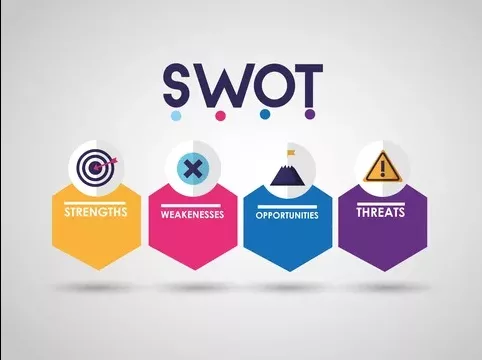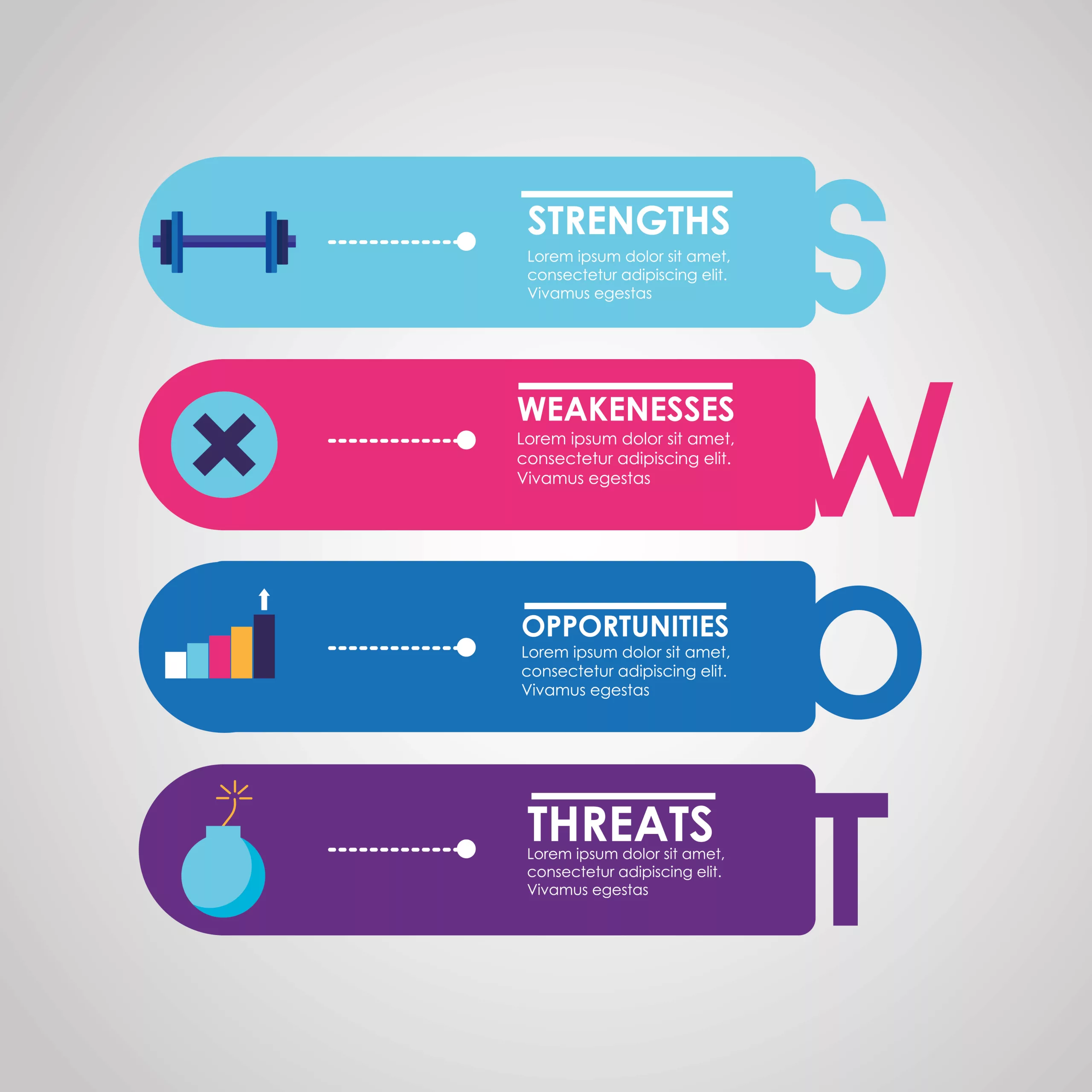In business and strategic planning, a SWOT analysis is a powerful tool for evaluating an organization’s current position and potential future directions. SWOT, which stands for Strengths, Weaknesses, Opportunities, and Threats, provides a comprehensive framework for assessing internal and external factors that can impact an entity. Let’s delve into the steps and nuances of conducting an analysis effectively.
In business and strategic planning, the analysis emerges as a formidable instrument, wielding the ability to meticulously assess an organization’s present standing and its conceivable trajectories for the future.
The acronym, SWOT, encapsulates the four critical dimensions of this analytical framework: Strengths, Weaknesses, Opportunities, and Threats.
It is within this methodical amalgamation that an all-encompassing structure is forged. One that allows for the comprehensive evaluation of both the inner workings and the external influences that cast their shadow upon an enterprise.
To grasp the intricacies and the systematic intricacies of an analysis, let us embark on a journey through its meticulous steps.
Unveiling the Essence of SWOT Analysis
In the narrative of strategic prowess, a SWOT finds its foundation. An emblematic fixture that unfurls the potential within an entity. The emblematic quartet, each encapsulated in the acronym, imparts a multifaceted perspective that is indispensable for informed decision-making.
Before diving into the details, let’s break down the acronym. SWOT stands for:
- Strengths: Internal attributes or resources that give an organization an advantage.
- Weaknesses: Internal attributes that place an organization at a disadvantage.
- Opportunities: External factors that could be advantageous to the organization.
- Threats: External factors that could potentially harm the organization.
Components of SWOT Analysis
The art of analysis is akin to the masterful orchestration of a symphony—where the four dimensions intertwine in harmonious unison, revealing the tapestry of an entity’s potential.
It is within these lines and curves that the artistry of strategic insight flourishes, encapsulating the essence of SWOT—Strengths, Weaknesses, Opportunities, and Threats.
1. Strengths: Unveiling the Inner Prowess
Embedded within the “S” of SWOT is a repository of an organization’s internal potency. Strengths, these inherent assets, propel an entity forward on the trajectory of accomplishment.
These might encompass a renowned brand reputation, an adept and dynamic workforce, cutting-edge technological infrastructure, or streamlined operational processes.
These strengths not only bolster the entity’s standing but serve as the bedrock upon which future growth is nurtured.
2. Weaknesses: Confronting the Achilles’ Heel
Peering into the realm of “W”—Weaknesses—illuminates the facets that demand refinement. These are the internal frailties that have the potential to hinder progress, impede innovation, or mark the overall effectiveness of an organization.
Inadequate resources, sluggish adaptability, or fractured communication channels might fall within this category. Identifying these frailties is the initial step toward mitigation and transformation.
3. Opportunities: Navigating Uncharted Waters
The outer periphery of the SWOT spectrum, “O”—Opportunities—beckons with prospects and potential. These external forces, akin to the winds of change, bear the promise of growth and advancement.
Emerging market trends, unexplored consumer niches, technological breakthroughs, or strategic partnerships—all serve as the canvas upon which an organization can paint its future accomplishments.
4. Threats: The Shadows That Loom
The veil of uncertainty that shrouds the business landscape is uncovered through the “T” of SWOT—Threats. These are external elements that have the potential to cast a shadow over an organization’s trajectory.
Economic downturns, fierce market competition, regulatory upheavals, or technological disruptions are examples of these lurking perils. Identifying and preparing for these threats becomes an essential act of resilience.
The Strategic Choreography: Steps to an Effective SWOT Analysis
![]()
![]()
The systematic rendition of a SWOT analysis follows a well-orchestrated sequence—each step harmoniously resonating with the other, creating a symphony of insights.
1. Unearthing Strengths and Weaknesses
At the inception, the focus is on introspection. Delve into the organizational intricacies to unearth strengths that stand as testimonials to the journey thus far, as well as weaknesses that bear testimony to areas deserving of transformation.
2. Pioneering into Opportunities and Threats
With the internal canvas painted, the landscape of opportunities and threats unfolds. This step involves navigating the external currents—identifying opportunities that align with the organizational trajectory and delineating threats that may challenge this very path.
3. The Analysis and Prioritization Dance
Once the quartet of dimensions is populated, the analysis stage ensues. This is the crucible where the true essence of SWOT is refined. Each dimension is meticulously weighed, its impact assessed, and its significance discerned. It is here that the strategic compass takes form, pointing the way toward prioritization.
The SWOT analysis, in all its facets, emerges not merely as a static framework but as an interactive journey—one that draws strength from the interplay between dimensions, fostering an informed perspective that informs the very essence of strategic decision-making.
As the landscape of business and strategic planning continues to evolve, the analysis retains its vantage point as a beacon of enlightenment—a tool that pierces through the complexities, presenting a distilled essence of an organization’s present and future.
Importance of SWOT Analysis
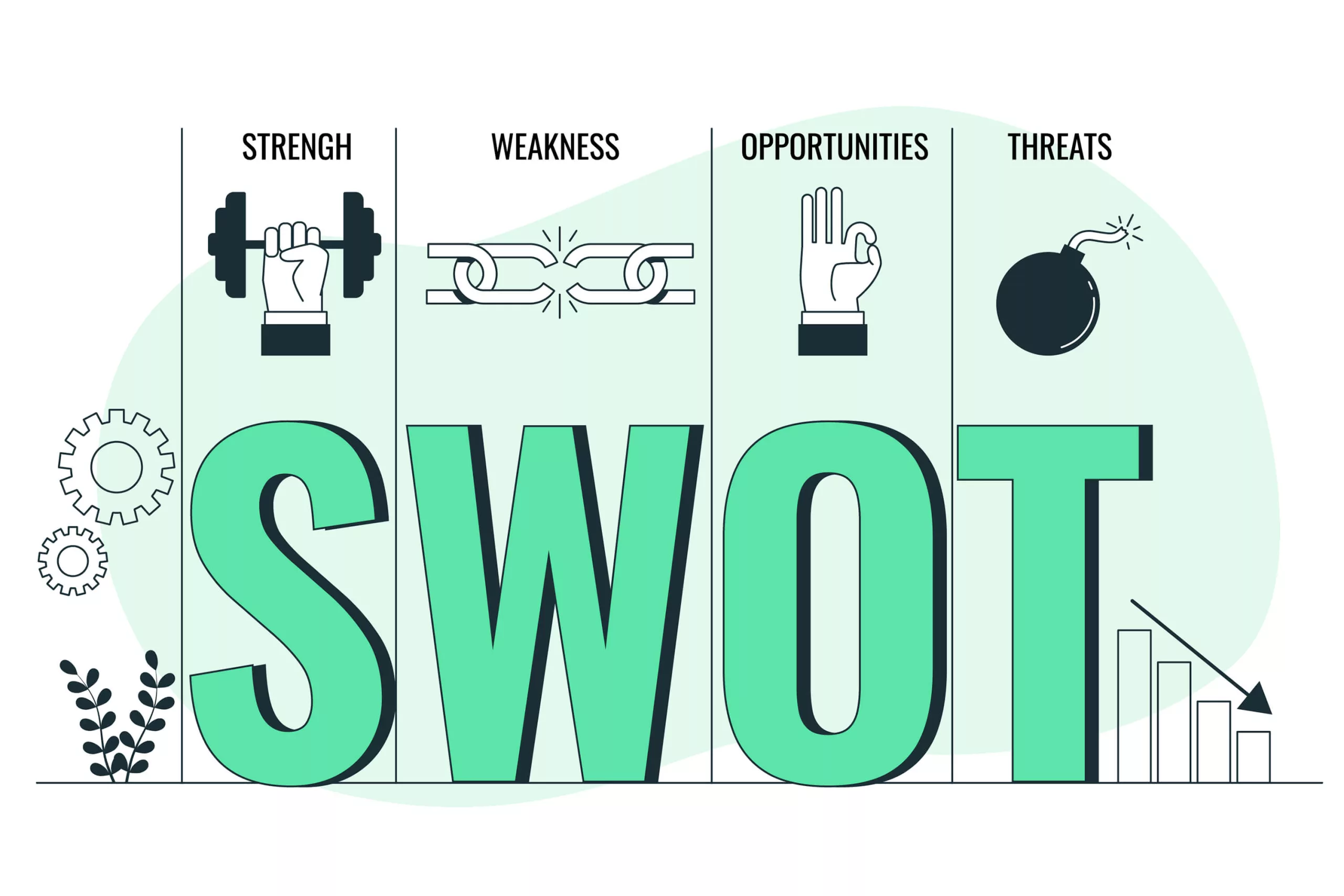

An analysis offers a structured approach to scrutinizing various facets of an entity. By identifying strengths and weaknesses, organizations can capitalize on their assets while addressing areas of improvement. Simultaneously, the assessment of opportunities and threats empowers organizations to proactively adapt to their environment.
In the dynamic theater of business strategy, the analysis stands as an invaluable guide—an intellectual compass that navigates the complexities of an ever-shifting landscape. Its structured approach invites organizations to unravel the multifaceted layers that constitute their existence.
Through a meticulous dissection of strengths, weaknesses, opportunities, and threats, the analysis becomes an indispensable tool for both introspection and strategic evolution.
Leveraging Strengths, Confronting Weaknesses
One of the foundational pillars of the SWOT analysis lies in its capacity to spotlight an organization’s strengths and weaknesses. When a company unveils its strengths—be it a renowned brand identity, a robust supply chain, or an agile workforce—it crafts a narrative of its competitive edge. These attributes serve as the springboard from which innovation is launched and excellence is pursued.
In parallel, the identification of weaknesses serves as a reality check—a mirror reflecting areas demanding transformation. This introspective scrutiny reveals the chinks in the armor—inefficiencies, operational bottlenecks, or resource limitations—that can be addressed to elevate overall performance.
Navigating Opportunities, Confronting Threats
SWOT extends its purview to the external theater, where opportunities and threats take center stage. In the realm of opportunities, the analysis unearths hidden gems nascent markets, untapped consumer segments, technological advancements.
That can propel an organization’s growth. This keen discernment of opportunities offers a competitive edge by harnessing new avenues for expansion.
Simultaneously, the scrutiny of threats serves as a sentinel guarding against complacency. By identifying potential pitfalls such as market disruptions, economic downturns, or regulatory changes, organizations can be proactive in devising contingency plans and adaptation strategies.
Real-Life Instances: The Power of SWOT Analysis
The potency of analysis finds embodiment in real-life narratives. Consider the case of Netflix. In its early years, Netflix meticulously conducted a analysis, revealing its strengths in pioneering streaming technology and weaknesses in the face of brick-and-mortar video rental giants.
This introspective revelation guided its transformation into a digital powerhouse, capitalizing on technological prowess while addressing the limitations of its original business model.
Similarly, the automotive industry’s shift toward electric vehicles is steeped in the recognition of opportunities and threats uncovered by a SWOT analysis.
The opportunity to align with environmentally conscious consumers and technological advancements in battery efficiency propelled the industry forward. Simultaneously, the looming threat of fossil fuel depletion and increasing emissions regulations necessitated a strategic pivot toward sustainable alternatives.
Proactive Evolution in a Dynamic Landscape
The analysis crystallizes into an agent of proactive evolution—a compass that guides organizations through the labyrinth of choices. Its structured examination, backed by real-life instances, underscores the significance of its application.
By addressing weaknesses, organizations engineer their own metamorphosis, while by embracing opportunities and confronting threats, they navigate the currents of change with agility.
In the grand narrative of business strategy, the SWOT analysis is a script replete with layers of significance. It is the playbook that propels organizations beyond survival, into the realm of strategic resilience and growth.
By capitalizing on strengths, conquering weaknesses, harnessing opportunities, and mitigating threats, businesses emerge as architects of their destiny—a destiny sculpted not by circumstance, but by the calculated choices fostered by the analysis.
When to Use SWOT Analysis?
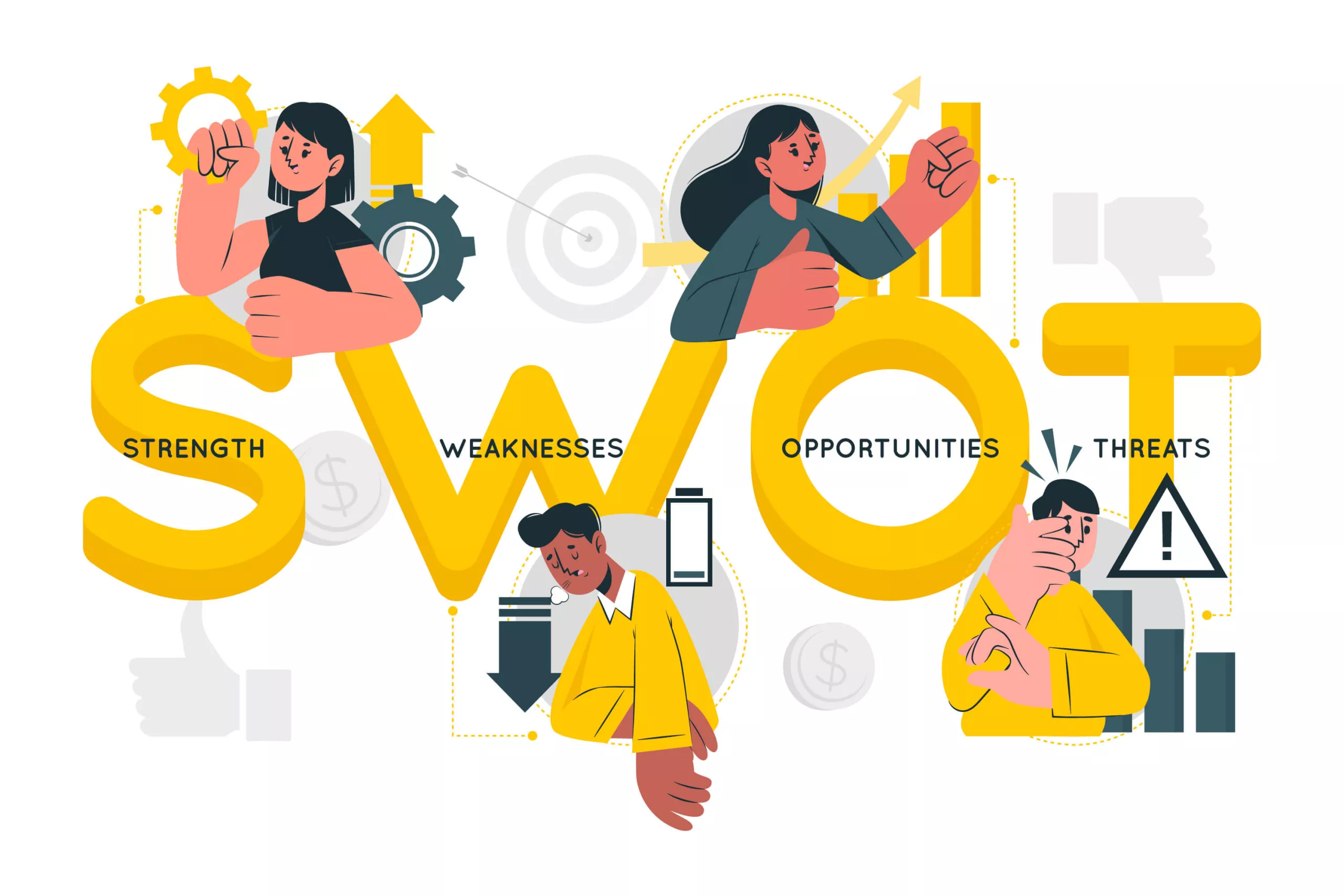

The versatility of the SWOT transcends the confines of a static tool—it thrives as a dynamic compass that navigates the vast expanse of business landscapes.
This navigational prowess finds its essence in the strategic timing of its application, allowing it to illuminate a myriad of scenarios and unveil insights that transcend the mundane. Herein lies the art of recognizing the opportune moments for its deployment.
Crafting Business Strategies
In the tapestry of strategic acumen, the SWOT stands as the foundational stitch—a weave that provides invaluable insights. When crafting business strategies, this analytical prism serves as the catalyst for informed decision-making.
By scrutinizing internal strengths that can be leveraged, weaknesses that need mitigation, external opportunities that can be seized, and threats that demand vigilance, organizations paint a vivid canvas of their strategic roadmap.
The Genesis of New Products or Services
When unveiling new products or services, this analytical tool unravels the uncharted domains of possibilities. It dissects the very fabric of innovation—shedding light on how strengths can be harnessed to elevate the novelty.
How weaknesses can be addressed to fortify the offering, and how opportunities and threats can be interwoven to carve a unique niche in the market.
Navigating Market Entry Feasibility
The genesis of entering new markets is fraught with intricacies. Here, the SWOT analysis takes on the role of an avant-garde explorer—a harbinger of insights that pave the way. By dissecting the feasibility of market entry, it evaluates the harmony between strengths and the market’s demands.
The adaptability of weaknesses to local conditions, the compatibility of opportunities with untapped market segments, and the preparedness to confront potential threats.
Evaluating Ongoing Projects or Processes
A continual audit of ongoing projects or processes is the pulse of progress. The analysis functions as a diagnostic tool, gauging the vitality of these endeavors.
It navigates the intricate labyrinth of execution illuminating areas where strengths are capitalizing effectively, where weaknesses are impeding progress, where opportunities remain untapped, and where lurking threats need mitigation.
Orchestrating Organizational Improvement
Organizational growth is an ongoing symphony. Amidst this symphony, the analysis emerges as a conductor—an orchestrator of improvement. It identifies the cadence of organizational dynamics.
Directing efforts to amplify strengths, remedy weaknesses, maximize opportunities, and preemptively neutralize threats. This orchestration is the very heartbeat of sustained enhancement.
The Real Life Case Masterpiece of Strategic Insight
As the final stroke of the brush is applied, the masterpiece of strategic insight emerges—a vivid tableau of strengths and weaknesses, opportunities and threats. This canvas is not static; it breathes with the pulse of organizational vitality.
The brilliance of the SWOT analysis lies not only in its systematic steps but in its holistic perspective. It harmonizes the internal rhythm with the external melody, culminating in a symphony of informed decision-making.
Strengths might encompass a distinguished brand identity, a robust talent pool, technological innovations, or optimized operational processes.
In contrast, weaknesses could manifest as resource limitations, outdated infrastructure, communication barriers or inefficient workflows. This raw introspection sets the stage for a journey of transformation.
Real-world exemplars echo the transformative power of this choreography. Consider Coca-Cola—a brand that leveraged its strengths in global recognition and diversified product portfolio to counterbalance the weakness of changing consumer preferences.
Meanwhile, the rise of Tesla is emblematic of identifying the opportunity in the automotive industry’s shift toward electric vehicles and using it to eclipse the threat posed by fossil fuel dependency.
In the cadence of these steps lies the soul of strategic navigation—a journey that commences with introspection, ventures into the realm of possibilities, and culminates in prioritization.
The analysis transcends the realm of methodology, metamorphosing into an odyssey of insights—a choreography that guides organizations through the ballet of strategic decision-making.
Unveiling the Business Wisdom: Benefits of SWOT Analysis


In the realm of strategic enterprise, the analysis unfurls its banner of advantages—a tapestry woven with threads of informed decision-making, judicious resource allocation, and proactive risk mitigation. This methodology transcends the mundane, elevating businesses to the echelons of astute navigation and fortified resilience.
Informed Decision Making: Guided by Clarity
Picture the labyrinth of decision-making as a map veiled in mist. In this landscape, the analysis acts as a beacon—a clarion call that dispels uncertainty. By distilling internal strengths, weaknesses, external opportunities, and threats, it illuminates a clear pathway.
Armed with this lucidity, businesses make decisions that align with their strategic direction, thus transcending the realm of conjecture and entering the domain of strategic foresight.
Resource Allocation: Focus Amidst Abundance
The allocation of resources, akin to managing a treasury, necessitates judicious discretion. Here, the SWOT metamorphoses into an advisor—an entity that directs resources with precision. By identifying priorities amidst the array of dimensions, the allocation process becomes more focused.
Strengths can be magnified, weaknesses mitigated, opportunities capitalized upon, and threats neutralized—each action carefully calibrated to foster optimal returns.
Risk Mitigation: Proactive Anticipation
In the dynamic theatre of business, the unknown lurks as a constant companion. Yet, the SWOT does the role of a guardian—a sentinel that anticipates threats before they materialize.
By unearthing potential pitfalls, it empowers businesses to craft mitigation strategies in advance. This vigilance transforms risks from lurking shadows to navigable waters, rendering the journey less treacherous.
Navigating the Boundaries: The Limitations of SWOT Analysis
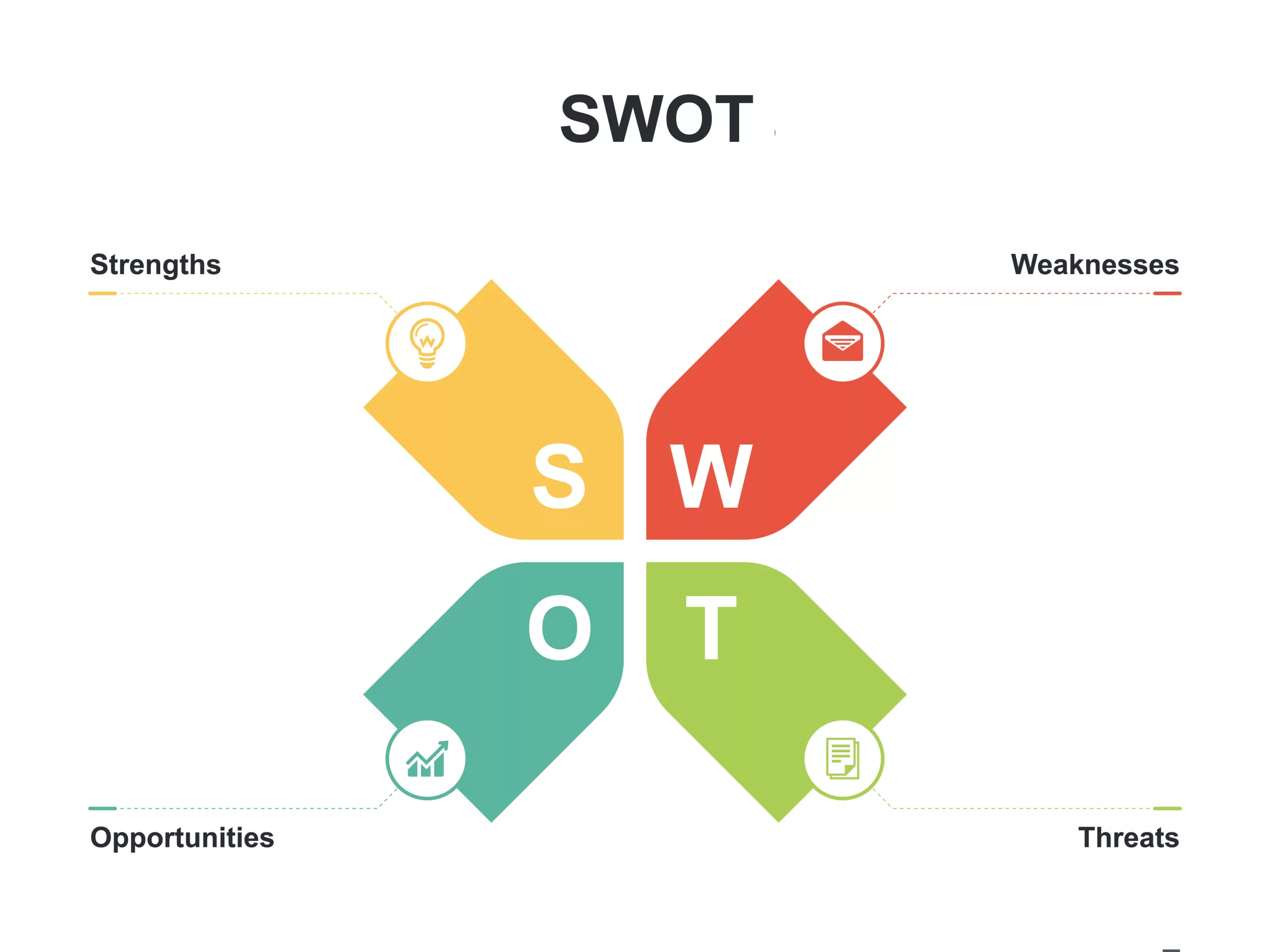

While the virtues of SWOT are myriad, it does possess boundaries that warrant acknowledgment.
Simplicity: A Double-Edged Sword
The very simplicity that renders SWOT accessible also begets its limitation. In the midst of intricate situations, the framework might condense complexities, resulting in an oversimplification that fails to capture the nuanced layers.
It becomes imperative to recognize that not all challenges can be encapsulated within these four dimensions.
Static Analysis: A Glimpse in Time
Imagine capturing a waterfall’s majesty in a single photograph—it is but a snapshot, devoid of the waterfall’s dynamic flow. Similarly, the SWOT offers a glimpse in time—a static depiction that might not encompass the evolving dynamics.
In a swiftly changing business landscape, the analysis might miss the fluid transitions that unfold beyond the frame.
Biased Perspectives: The Human Tint
As the brush of analysis meets the canvas of perception, individual biases can subtly shade the outcome. Personal viewpoints, conscious or subconscious, can influence the interpretation of factors. This introduces an element of subjectivity that might not always mirror objective reality.
The Equilibrium of Insight and Caution
In the grand narrative of strategic maneuvering, the benefits of SWOT hold hands with its limitations—an equilibrium where insight commingles with caution. Businesses navigate this duality, embracing the virtues while acknowledging the confines.
The saga of SWOT analysis is a saga of empowerment—a saga that equips businesses with a compass of clarity, a lamp of allocation, and a shield of foresight. It is within this synergy of advantages and limitations that businesses embark on a journey—a journey marked not only by decisions.
But by enlightened decisions, calibrated allocations, and anticipatory strategies. The analysis is not merely a methodology; it is a symphony—an orchestration that resonates with the rhythm of business wisdom.
Conclusion
As the symphony of analysis reaches its crescendo, the culmination of an analysis bears testimony to its prowess—a prowess that transcends methodology and becomes the cornerstone of strategic brilliance.
The journey through strengths, weaknesses, opportunities, and threats converges into a panoramic view—a view that resonates with clarity, foresight, and empowerment.
A well-executed SWOT analysis emerges not as a mere tool but as a guiding star—a luminary that illuminates the crossroads of decisions.
The holistic panorama it unveils—laying bare the intricacies of an organization’s internal communication and the external currents that ebb and flow—becomes the compass that navigates challenges and unfurls the canvas of opportunities.
The significance of an analysis is not confined to its utility; it’s in the transformation it instigates. Armed with insights, organizations transcend the realm of passivity and venture into the territory of action—action rooted in awareness, action poised for success.
This is the narrative that underscores the importance of this analytical journey—an odyssey that equips businesses to embrace transformation, navigate the tides of change, and ultimately flourish in the vibrant panorama of the business landscape.
As the final note resonates, the stage is set for organizations to embark on a trajectory that isn’t merely marked by survival, but by the symphony of growth, the sonata of innovation, and the saga of strategic mastery.
In the symphony of strategic maneuvering, the SWOT analysis emerges as the conductor—a conductor that orchestrates decisions with precision. Aligns resources with acumen, and transforms challenges into stepping stones.


